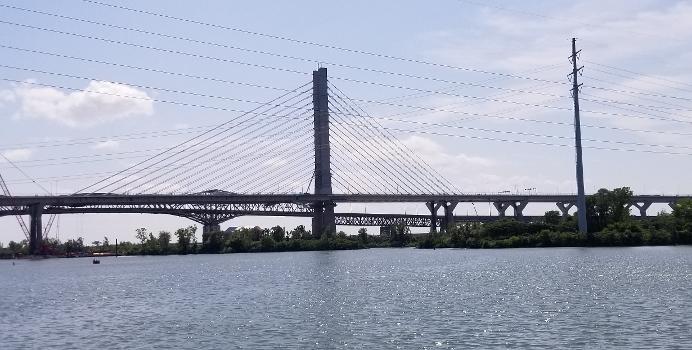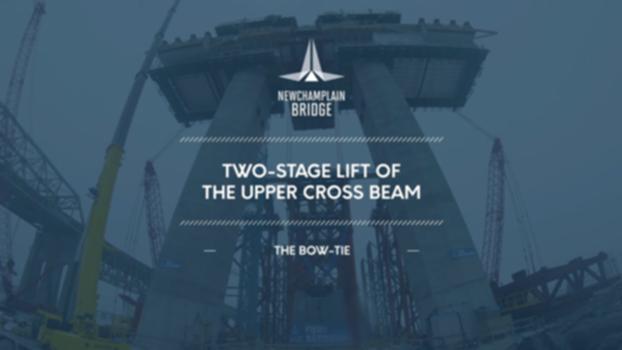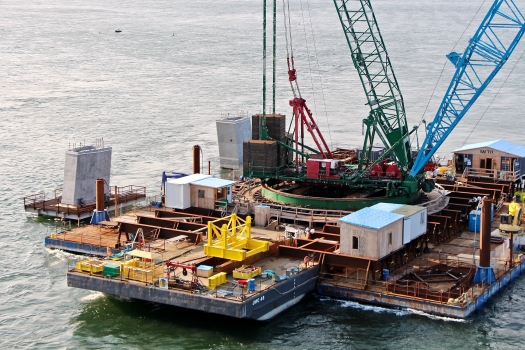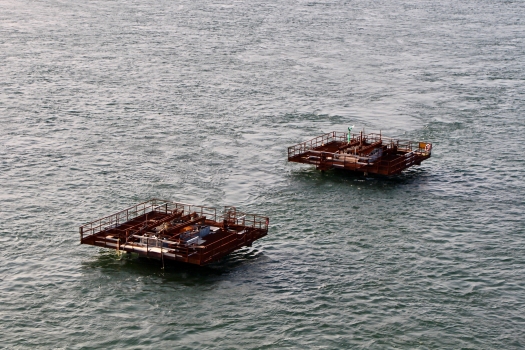General Information
Project Type
| Structure: |
Cable-stayed bridge with harp system Two-span cable-stayed bridge |
|---|---|
| Support conditions: |
for registered users |
| Secondary structure(s): |
Structurae Plus/Pro - Subscribe Now! Structurae Plus/Pro - Subscribe Now! |
| Function / usage: |
Motorway bridge / freeway bridge |
| Material: |
Steel-reinforced concrete composite bridge Structurae Plus/Pro - Subscribe Now! Structurae Plus/Pro - Subscribe Now! |
Location
| Location: |
Montreal, Montréal, Quebec, Canada Brossard, Montérégie, Quebec, Canada |
|---|---|
| Above of: |
|
| Replaces: |
Champlain Bridge (1962)
|
| Coordinates: | 45° 28' 13.35" N 73° 32' 3.73" W |
| Coordinates: | 45° 28' 0.73" N 73° 29' 31.55" W |
Technical Information
Dimensions
| main span | 240 m | |
| total length | 3 400 m | |
| deck 1 | deck depth | 3.630 m |
| total width | 17.045 m | |
| roadway / carriageway width | 16.045 m | |
| deck 2 | deck depth | 3.620 m |
| number of tracks | 2 | |
| total width | 10.870 m | |
| deck 3 | deck depth | 3.630 m |
| total width | 17.045 m | |
| roadway / carriageway width | 16.045 m | |
| pylon | height from foundation level | 170 m |
Quantities
| structural steel | 72 700 t | |
| concrete volume | 107 000 m³ | |
| prestressing steel | 1 110 t | |
| stay cables | steel for cable-stays | 1 120 t |
Cost
| cost of construction | ca. Canadian dollar 2 150 000 000 |
Materials
| pylon |
reinforced concrete
precast reinforced concrete |
|---|---|
| piers |
reinforced concrete
|
| pier heads |
steel
|
| main girders |
steel
|
Case Studies and Applied Products
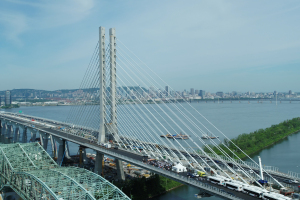
Guided Cross-Tie: Highly innovative railway joint for extreme demands
Guided Cross-Ties are an innovative expansion joint system that has only been used on railway bridges a few times worldwide. The new Champlain Bridge over the St. Lawrence River boasts one of the largest eve ... [more]
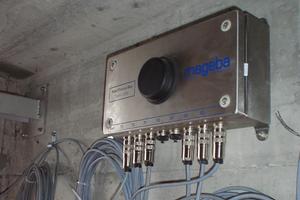
ROBO®CONTROL Permanent – Remote Monitoring System
Robo®Control detects the absence of machine specifications at the component and conveys these to a central computer. There the data are processed and they are made available to the clients through internet.
[more]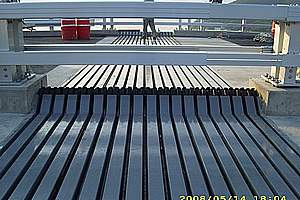
TENSA®MODULAR LR & LR-LS – Modular expansion joints
Modular Expansion Joints can be constructed for any movements, from about 100 mm up to 2,000 mm and more. They allow movements in all 3 directions and rotations around all 3 axes.
[more]Excerpt from Wikipedia
The Samuel De Champlain Bridge, colloquially known as the Champlain Bridge, is a cable-stayed bridge designby architect Poul Ove Jensen and built to replace the original Champlain Bridge over the Saint Lawrence River in Quebec between the Island of Montreal and the South Shore suburbs. The new span is located just north of the original Champlain Bridge, which is currently being demolished. The new bridge carries eight lanes of automobile traffic of the A-10, A-15, and A-20, with one lane in each direction dedicated for buses. It also includes a multi-use lane for cyclists and pedestrians. The central portion of the bridge deck, still under construction, will carry the South Shore branch of the forthcoming Réseau express métropolitain (REM) automated light rail system. At 60 metres (200 ft) wide, the new Champlain Bridge is the widest cable-stayed bridge in the world that uses two planes of cables.
It is one of the largest infrastructure projects in North America and is one of the busiest crossings on the continent. It is built to last 125 years with the usage of stainless steel and high-performance concrete, and replaces the previous 57-year-old bridge, which has become functionally obsolete and its structure having been degraded by the repeated application of de-icing salt.
Specifications
The Champlain bridge is a 3.4-kilometre (2.1 mi) crossing. It includes an asymmetric cable-stayed bridge with a 240-metre (790 ft) main span, a 168-metre-high (551 ft) concrete tower, and stay cables in a harp arrangement. The asymmetrical back span is 124 metres (407 ft). The 2,044-metre (6,706 ft) west approach structure has 26 spans that are typically 80.4 metres (264 ft).The east approach is 780 metres (2,560 ft) long and includes a 109-metre (358 ft) span over Route 132.
The bridge was built as part of a larger $4 billion project that included:
- The Samuel-de-Champlain Bridge
- A new Autoroute 10 (A-10) approach
- A new 470-metre (1,540 ft) île-des-Sœurs bridge and a highway on île-des-Soeurs
- Improvements to nearby parts of the A-15
The design of the Champlain Bridge addressed seismic activity, soil liquefaction, light-rail transit loading, ship collision, and ice loading. The bridge is configured with three separate decks, one for each direction of vehicular traffic and a third in the center for the Réseau express métropolitain rail corridor. The northbound deck is wider to include a multi-use corridor for cyclists and pedestrians, requiring the cable-stay bridge to be asymmetric in the transverse direction as well as longitudinal. The main tower is shaped like a tuning fork and is supported by 21 1.2-metre (3.9 ft) drilled piles. The decks are supported in the approach spans by W-shaped piers.
Construction history
In September 2007, faced with rising costs for the maintenance of the Champlain Bridge (commissioned in 1962), then Canadian Minister of Transport Lawrence Cannon confirmed that his department was seriously considering the construction of a replacement structure. In August 2008, Transport Canada announced that it was exploring different scenarios for a new bridge. In October 2011, then Minister of Transport Denis Lebel officially announced that construction on the new bridge would begin within 10 years.
In November 2014, then Minister of Transport Lisa Raitt announced that she was abandoning the idea of naming the new bridge in honor of Maurice Richard after consulting the family of the former ice hockey champion. Prior to the 2015 Canadian federal election, the 28th Canadian Ministry planned on imposing a $2-$4 toll on the new bridge, however, this plan was abandoned following the election of the 29th Canadian Ministry.
In April 2015, the federal government selected the JV consortium: Signature on the St. Lawrence Group to build the new bridge. The consortium mainly includes: SNC-Lavalin, ACS Infrastructure, and Dragados Canada. T.Y. Lin International is serving as the Lead Designer.
Construction on the new bridge officially began on June 16, 2015. On December 19, 2018, Minister of Infrastructure and Communities François-Philippe Champagne announced that the official name of the new bridge will be the Samuel-de-Champlain Bridge. The bridge opened to northbound/westbound traffic on June 24, 2019 (St-Jean-Baptiste Day), with the official opening ceremony being held on June 28, 2019, and southbound/eastbound traffic opening on July 1, 2019 (Canada Day). The multi-purpose runway was opened in November 2019, while the REM train tracks are expected to be opened in 2021.
Construction method
This section . (May 2020) View from the westbound roadway
In order to meet the 42-month construction deadline, many steel and concrete bridge elements were prefabricated, with a portion of the work taking place on temporary piers. Three jetties were built: one on the east from Brossard, one on the west from Nuns' Island, and one from the center, adjacent to a dike along the Saint Lawrence Seaway.
- The pier through the canal, allowed, by means of cofferdams, the storage of piles of construction material.
- The central jetty served as a construction platform for the piers and towers of the section of the bridge utilizing guy-wires. Temporary pillars used during the construction of the Millau Viaduct in France were erected to support the cable-stayed span during construction. The main cable-stayed span above the seaway was assembled in segments by means of a crane.
- The 500-meter (550 yards) long west pier was divided into three pre-assembly areas: a first for the concrete foundation footings that serve as the base for the viaduct section crossing the river, a second for the steel headers that complete the piles, and a third for the steel superstructures that wear the aprons. During the prefabrication of the 38 marine insoles, a pile primer and working platform were added to form a pile base measuring up to 14 meters (45') high. A super-transporter moved these stack bases from the prefabrication area to a loading area from where they were lifted by an industrial catamaran. The catamaran then deposited these bases in spaces drilled to a depth of 4 to 5 meters (15') in the riverbed. Two floating cranes finally overlaid the bases of the prefabricated elements to form piles and headers. The steel box girders supporting the three decks of the bridge were then deposited on the trimmers as they were completed.
Text imported from Wikipedia article "Champlain Bridge, Montreal (2019–present)" and modified on 02 September 2020 according to the CC-BY-SA 3.0 license.
Participants
- Ove Arup & Partners
-
Provencher Roy Associés Architectes Inc.
- Claude Provencher (designer)
-
Dissing+Weitling arkitektfirma a/s
- Poul Ove Jensen (architect)
- ACSA Obras e Infraestructuras S.A.
- Dragados
- Flatiron Constructors Canada
- HOCHTIEF PPP Solutions GmbH
- SNC-Lavalin
- mageba group
- MAURER SE (railroad bridge)


Relevant Web Sites
Relevant Publications
- (2017): Design and Construction of the New Champlain Bridge, Montreal, Canada. In: Structural Engineering International, v. 27, n. 1 (February 2017), pp. 38-43.
- (2019): Design and Construction of the Samuel De Champlain Bridge, Montreal, Canada. Presented at: IABSE Congress: The Evolving Metropolis, New York, NY, USA, 4-6 September 2019, pp. 2329-2336.
- (2017): Design of the Cable-Stayed Bridge Signature Span of the New Champlain Bridge. Presented at: IABSE Symposium: Engineering the Future, Vancouver, Canada, 21-23 September 2017, pp. 2075-2082.
- (2019): Design Quality Management of The New Samuel De Champlain Bridge. Presented at: IABSE Congress: The Evolving Metropolis, New York, NY, USA, 4-6 September 2019, pp. 1820-1828.
- (2017): Highway Approaches of the New Champlain Bridge Corridor. Presented at: IABSE Symposium: Engineering the Future, Vancouver, Canada, 21-23 September 2017, pp. 2090-2097.
- About this
data sheet - Structure-ID
20067927 - Published on:
19/10/2015 - Last updated on:
29/06/2022


